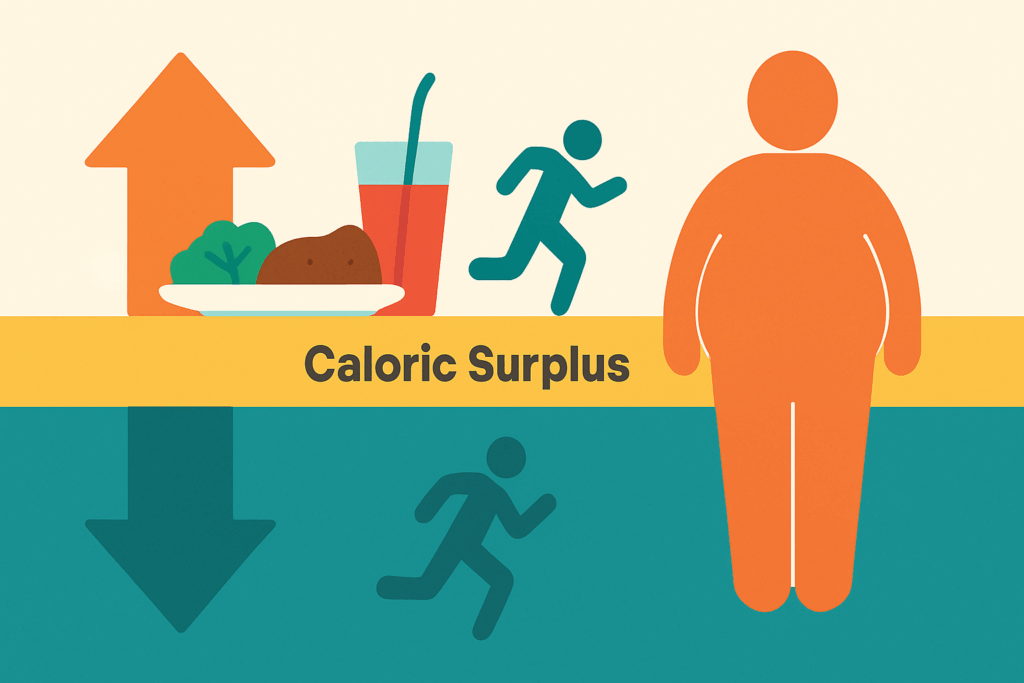In the realm of fitness and wellness, the question “how many calories should I eat to gain weight?” is one that has sparked countless debates, fueled endless meal plans, and shaped the routines of athletes and health-conscious individuals alike. Contrary to the cultural emphasis on weight loss, there exists a substantial population for whom the primary health goal is to gain weight in a way that is sustainable, healthy, and aligned with optimal body composition. Whether one seeks to gain lean muscle, recover from illness, or simply achieve a healthier weight, the journey begins with understanding the foundational concept of caloric intake and how it supports bodily growth and repair.
You may also like: 4 Ways to Have a Healthy Diet: Expert Tips Backed by Science for Better Nutrition and Long-Term Wellness
The Science Behind Weight Gain and Caloric Surplus
Weight gain, in its simplest form, requires a caloric surplus—consuming more calories than the body burns. However, the science of achieving this surplus in a healthy manner involves far more nuance than simply eating more. The human body is a dynamic system where metabolism, hormonal regulation, activity levels, and genetics all influence how calories are processed and stored. To gain weight effectively, individuals must calculate their Total Daily Energy Expenditure (TDEE) and then strategically exceed that number through dietary intake.
This is where the calorie calculator to gain weight becomes essential. These calculators use data such as age, weight, height, gender, and activity level to estimate the number of calories needed to maintain current weight. To gain weight, one must consume above this maintenance level—typically an additional 250 to 500 calories daily. However, a blanket increase doesn’t work for everyone, which is why the use of a personalized weight gain calculator or weight gain estimator ensures precision in planning.

Differentiating Between Types of Weight Gain
Not all weight gain is created equal. There’s a significant difference between gaining lean muscle and accumulating excess fat. For those focused on aesthetics, athletic performance, or metabolic health, the goal is to increase lean body mass rather than simply adding pounds. Here, the quality of calories becomes just as important as quantity. Macronutrient distribution—particularly protein intake—must be carefully considered.
A calorie calculator for muscle gain can help determine the optimal ratio of protein, carbohydrates, and fats to support muscle synthesis while minimizing fat accumulation. Tools such as a bulking calorie calculator or a calories to gain muscle mass calculator often integrate with fitness trackers and dietary apps to help users balance their intake. These digital tools empower individuals to make smarter nutritional choices tailored to their unique physiology.
Understanding Metabolism and Adaptive Thermogenesis
One of the often-overlooked aspects of weight gain is the body’s adaptive response to increased caloric intake. Known as adaptive thermogenesis, this process causes the metabolism to ramp up slightly as more energy becomes available, making it harder to gain weight over time. For this reason, periodic recalibration of your calorie surplus calculator is crucial. What works for the first two weeks of a bulking phase may become insufficient by the sixth week.
In practice, this means regularly adjusting your intake using updated data from a reliable weight gain estimator or bulking calculator. Paying attention to weight trends, body composition changes, and performance metrics can offer additional insight. Advanced calculators may also factor in the thermic effect of food and non-exercise activity thermogenesis (NEAT), offering a more complete view of caloric needs.

Protein, Carbs, and Fats: Building Blocks for Muscle Growth
Effective weight gain is as much about macronutrient composition as it is about calorie count. Protein plays a central role in muscle repair and growth, and consuming 1.2 to 2.2 grams of protein per kilogram of body weight is generally recommended for those in a bulking phase. A calorie calculator for muscle gain will often emphasize high-quality protein sources like lean meats, dairy, legumes, and plant-based alternatives.
Carbohydrates, meanwhile, provide the energy necessary for intense workouts and recovery. Fats are essential for hormone regulation and cellular function. Understanding how these macronutrients contribute to the calories to gain weight allows individuals to prioritize meals that are not only calorie-dense but also nutrient-rich. An advanced calories to gain weight calculator may also guide users on how to distribute these macronutrients across meals and days for maximum efficiency.
Psychological and Emotional Considerations in Weight Gain
Gaining weight, especially for individuals who have struggled with low body weight or disordered eating, can be psychologically challenging. Unlike dieting for weight loss, which is often socially reinforced, intentional weight gain can be met with misunderstanding or stigma. Navigating this landscape requires a thoughtful approach that includes self-compassion, goal setting, and support.
Using tools like a weight gain calculator or calorie calculator to gain weight can provide a sense of structure and control, which can be reassuring for those unsure where to begin. Additionally, incorporating the insights of dietitians, therapists, or health coaches can offer personalized guidance that addresses emotional roadblocks. Ensuring that emotional health remains central during the process of physical transformation is a key pillar of long-term success.

Common Mistakes and Misconceptions About Calorie Surplus
Many individuals assume that doubling or tripling their caloric intake will expedite weight gain. However, this often leads to gastrointestinal discomfort, unnecessary fat gain, and unsustainable eating habits. An effective bulking strategy requires a measured approach, where a gradual increase in calories is paired with resistance training to ensure that weight gain primarily reflects muscle development.
A cutting calculator, although designed for fat loss, can offer insights into how the body responds to different caloric levels. When transitioning from a cutting to a bulking phase, understanding these dynamics is critical. Moreover, tracking tools like a how many calories should I eat to gain weight calculator allow users to navigate this shift without experiencing rapid fat rebound.
The Role of Exercise in Healthy Weight Gain
Exercise—particularly strength training—is a non-negotiable part of any effective weight gain plan. Lifting weights signals the body to direct excess calories toward muscle repair and growth rather than fat storage. Progressive overload, compound movements, and adequate rest all support muscle hypertrophy.
When combined with insights from a calorie surplus calculator or calories to gain muscle mass calculator, exercise becomes not only a means of shaping physique but also a metabolic anchor. It’s essential to fuel workouts adequately, which might mean consuming a pre-workout snack rich in carbs and a post-workout meal containing both carbs and protein. The synergy between nutrition and training is what ultimately determines the quality of the weight gained.

Precision Tools for Caloric Tracking
Modern technology has revolutionized how individuals approach nutrition. From smart scales and food scanners to apps that integrate with wearable devices, the ability to monitor and adjust one’s diet has never been more accessible. A high-quality weight gain estimator or calorie calculator for muscle gain offers customizable recommendations that evolve with the user’s progress.
Among the most effective tools are those that include visual dashboards, macro breakdowns, and integration with fitness apps. These features not only streamline the process but also empower users to take ownership of their health journey. A bulking calorie calculator that incorporates user feedback, biometric trends, and goal adjustments ensures a dynamic approach to nutrition planning.
How to Interpret and Use Calculator Data Effectively
Simply using a calorie calculator to gain weight is not enough; understanding and interpreting the results is equally important. Caloric recommendations should be viewed as starting points rather than rigid prescriptions. Individual variability in digestion, metabolism, and physical activity means that real-world outcomes may differ from projections.
Keeping a food and training journal can help bridge the gap between calculated needs and lived experience. By recording meals, energy levels, mood, and performance, individuals can fine-tune their intake over time. Feedback loops between subjective experience and objective data from a weight gain calculator provide the insight necessary for sustained and safe progress.
Tailoring Strategies to Unique Populations
Caloric needs and weight gain strategies vary widely depending on factors like age, gender, medical history, and training background. For example, teenagers experiencing growth spurts may require significantly more energy than sedentary adults. Similarly, female athletes may have different macronutrient needs compared to their male counterparts, even when using the same weight gain estimator.
A personalized approach is essential. Tools like a how many calories should I eat to gain weight calculator can be refined through repeated use, becoming more accurate as more data is gathered. Working with a dietitian who can interpret the outputs of a calorie calculator for muscle gain ensures that unique biological needs are met without relying on generic recommendations.
Meal Planning for Muscle-Building Success
Designing meals that support weight gain without relying on processed foods is a cornerstone of long-term health. Whole-food ingredients, diverse nutrient profiles, and culinary creativity all contribute to a sustainable bulking plan. Using a calories to gain weight calculator as a guide, individuals can craft meal plans that combine taste, function, and nutrient density.
Meal timing also plays a role. Consuming more frequent meals or adding caloric beverages like smoothies and shakes can make it easier to meet daily targets. By using a calorie calculator to gain weight in tandem with meal prep strategies, one can create a seamless routine that removes decision fatigue and ensures consistency.
When to Reassess and Adjust Your Plan
As with any physiological goal, regular reassessment is key. Weight gain plateaus are common and often reflect changes in metabolism or adherence. A cutting calculator can be repurposed to assess whether a plateau is due to an increase in fat or a stall in muscle growth. Based on these insights, adjustments can be made to training or diet.
Advanced tools such as a how much calories should I eat to gain muscle calculator or a weight gain calculator that includes lean body mass projections offer more granular feedback. These refinements help keep progress aligned with goals and reduce the frustration that can come from stagnation.
Integrating Supplements Into Your Nutrition Plan
While whole foods should always form the foundation of any diet, supplements can play a supportive role in reaching caloric goals. Whey protein, creatine, and carbohydrate powders are frequently used by those aiming to increase muscle mass. However, these should complement, not replace, nutrient-rich meals.
The use of a bulking calorie calculator can guide whether a supplement is needed and how it fits into the broader nutritional framework. Supplements can also improve adherence by offering convenient options during busy schedules or after workouts when appetite is low. Careful selection and timing of supplements, guided by data from a calorie surplus calculator, enhance the overall effectiveness of a weight gain strategy.
Signs of Healthy Progress and Red Flags to Watch
While the number on the scale is one measure of progress, it is not the only one—and often not the most informative. Increases in strength, improved workout recovery, enhanced energy levels, and visual muscle definition all suggest that the weight being gained is beneficial. Body measurements and progress photos can supplement scale data for a fuller picture.
On the other hand, rapid weight gain, bloating, fatigue, and digestive issues may indicate an overly aggressive caloric surplus. These signs should prompt a review of current intake and possibly a recalculation using a how many calories should I have to gain weight tool. Listening to the body and seeking expert advice when needed ensures that gains are both sustainable and health-promoting.

Frequently Asked Questions: Advanced Strategies for Calculating and Managing Calories to Gain Weight
1. What’s the best way to track progress using a calorie calculator to gain weight?
To maximize results, using a calorie calculator to gain weight should be part of a broader, data-driven approach. Beyond simply inputting your stats, consider combining this tool with weekly progress photos, strength performance logs, and body composition tracking. Apps that sync with wearable fitness devices can enhance accuracy by reflecting daily energy expenditure, allowing you to adjust your intake in real time. The most effective users update their metrics frequently—at least every two weeks—to reflect changes in weight and activity. Over time, even minor discrepancies in how many calories you eat compared to your needs can lead to plateaus, so using the calculator dynamically is essential for continued progress.
2. How does a weight gain calculator differ when used for lean muscle versus overall mass?
A weight gain calculator can be tailored to focus either on lean muscle development or overall mass increase, depending on your goal inputs. When aiming for lean mass, the calorie surplus should be modest—typically 250 to 500 calories above maintenance—and paired with adequate protein intake and resistance training. For general mass gain, the calculator may recommend a larger surplus, which can lead to more fat accumulation if not monitored. This distinction is why pairing a calorie surplus calculator with a muscle-focused training regimen is crucial for quality weight gain. If you’re targeting muscle gain specifically, using a calorie calculator for muscle gain provides a more nuanced recommendation based on macronutrient distribution and recovery needs.
3. Can a cutting calculator be used to transition into bulking phases?
Surprisingly, yes. A cutting calculator is typically used to estimate a caloric deficit for fat loss, but it can serve as a baseline when transitioning into a bulking cycle. Once you understand your maintenance level from a cutting calculator, you can apply that data to a calorie surplus calculator to determine the appropriate increase in intake. This method ensures a smoother metabolic transition and may help prevent excessive fat rebound often seen with abrupt bulking. The key is to adjust the surplus incrementally and reassess how many calories to gain weight you truly need based on updated body composition metrics. Smart transitions between cutting and bulking phases support long-term physique goals and metabolic efficiency.
4. How do weight gain estimators account for different metabolic types or genetics?
Most weight gain estimators start with standard equations, such as the Mifflin-St Jeor or Harris-Benedict formulas, but they do not fully account for metabolic variances tied to genetics, gut microbiome diversity, or hormonal factors. This is why tracking real-world outcomes matters just as much as the initial output from any weight gain calculator. Individuals with fast metabolisms may need to recalculate how many calories should I eat to gain weight every few weeks, adjusting for increases in resting energy expenditure. Emerging technologies, such as continuous glucose monitors and personalized DNA assessments, are making their way into the development of more precise weight gain estimators. Until then, frequent self-monitoring remains your most powerful tool for personalization.
5. Is a bulking calorie calculator appropriate for women looking to gain muscle mass?
Absolutely. While traditionally used by male athletes, a bulking calorie calculator is equally valuable for women—especially those aiming to improve muscle tone or support athletic performance. The challenge lies in social norms and misconceptions that discourage women from eating in a calorie surplus. However, tools like a calorie calculator for muscle gain can help women determine how many calories should I eat to gain weight in a controlled, strategic way that supports lean mass and hormonal health. Additionally, using a calories to gain muscle mass calculator can aid in maintaining favorable body composition while supporting performance goals, whether for strength sports, aesthetics, or injury prevention.
6. What’s the role of a calorie surplus calculator in managing body recomposition goals?
For individuals pursuing body recomposition—simultaneously gaining muscle and losing fat—a calorie surplus calculator must be used with precision. Rather than following a traditional bulk or cut, this approach relies on slight surpluses during training days and potential deficits on rest days. In this context, how many calories should I have to gain weight becomes a variable rather than a fixed number. The calculator helps by setting a baseline that you can manipulate strategically based on workout intensity and macronutrient timing. This approach requires more nuanced meal planning but can produce impressive changes in body shape without dramatic weight fluctuations.
7. Can you trust how many calories should I eat to gain weight calculators during recovery from illness or injury?
Post-illness or injury recovery alters metabolic rate and tissue repair needs, which can make standard estimations less reliable. In such cases, a calorie calculator to gain weight should be viewed as a starting framework, not a strict rule. Healing tissue demands extra energy—especially protein and micronutrients—so your intake may need to exceed what a general weight gain estimator recommends. Tracking recovery markers like sleep quality, mood, and strength return is essential. When medical complications are involved, consider working with a registered dietitian who can adjust how many calories do I need to gain weight based on your unique physiology and healing status.
8. How do athletes modify a calories to gain weight plan around training load variations?
Athletes often deal with fluctuating training intensities and periods of deload or peak performance cycles, which dramatically affect their caloric needs. Rather than using a fixed plan, they adapt how many calories should I eat to gain weight by cycling intake around high- and low-output days. A calorie calculator for muscle gain can help outline a flexible strategy where surplus calories are timed to coincide with hypertrophy sessions or competition prep. On lighter training days, maintaining rather than gaining may be more beneficial for body composition. Integrating a weight gain calculator with training periodization creates a smarter, more sustainable approach to muscle development and energy availability.
9. What if a calorie calculator suggests an intake that feels unmanageable or excessive?
If the number from a bulking calorie calculator seems overwhelming, especially when trying to consume 3,500+ calories per day, it’s wise to approach the surplus gradually. Many people find that slowly increasing portion sizes, incorporating calorie-dense snacks, and focusing on liquid nutrition like smoothies helps reach their target without digestive discomfort. It’s also crucial to assess whether your body actually requires that much energy, or if the calorie calculator for muscle gain overestimated due to high activity assumptions. If you’re consistently feeling overly full or lethargic, refine the calculation based on satiety signals, and consult a professional to determine how much calories should I eat to gain muscle calculator outputs that truly reflect your needs.
10. Are there limitations in how many calories should I eat to gain weight calculators for older adults?
Yes, older adults often experience a natural decline in metabolism, muscle protein synthesis, and sometimes appetite, which makes gaining weight and especially muscle more complex. While most weight gain calculators offer inputs for age, they may not account for age-related anabolic resistance or medical conditions that affect nutrient absorption. For this demographic, the quality of calories often matters more than quantity. Utilizing a calories to gain muscle mass calculator that emphasizes protein adequacy and nutrient density is crucial. Moreover, resistance training becomes even more vital, as it signals the body to direct those extra calories toward muscle rather than fat accumulation.

Final Thoughts: Building a Body You Can Sustain
The journey to gaining weight effectively is not a sprint; it is a marathon guided by self-awareness, patience, and informed action. Using tools like a calorie calculator to gain weight or a calories to gain muscle mass calculator can provide structure and insight, but they must be complemented by intuitive eating, smart training, and personalized adjustments.
Whether you’re a competitive athlete or someone seeking to rebuild strength and confidence, understanding how many calories to gain weight is the first step. The key lies in strategic, evidence-based approaches that prioritize quality over speed. In doing so, individuals can cultivate not just a better physique, but also a more empowered relationship with food, fitness, and health.
With the right tools, guidance, and mindset, weight gain becomes more than a numerical goal—it becomes a catalyst for transformation that honors the body’s capacity to grow, adapt, and thrive.


